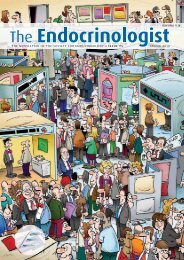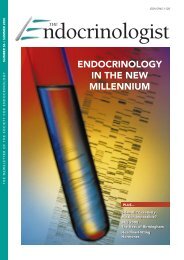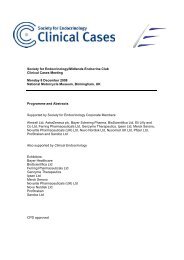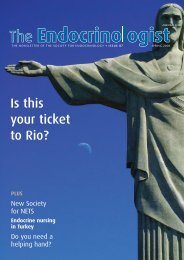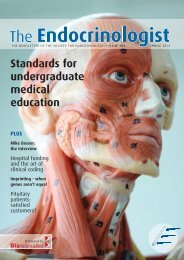Programme & Abstracts - Society for Endocrinology
Programme & Abstracts - Society for Endocrinology
Programme & Abstracts - Society for Endocrinology
Create successful ePaper yourself
Turn your PDF publications into a flip-book with our unique Google optimized e-Paper software.
in association with the South East Region Endocrine Club<br />
Friday 10 December 2010<br />
Lansdowne Place Hotel, Brighton, UK<br />
<strong>Programme</strong><br />
& <strong>Abstracts</strong><br />
Managed by
<strong>Society</strong> <strong>for</strong> <strong>Endocrinology</strong> Regional Clinical Cases Meeting<br />
In association with the South East Region Endocrine Club<br />
Friday 10 December 2010<br />
Lansdowne Place Hotel, Brighton, UK<br />
<strong>Programme</strong> and <strong>Abstracts</strong><br />
<strong>Society</strong> <strong>for</strong> <strong>Endocrinology</strong> Corporate Supporters:<br />
Platinum:<br />
BioScientifica Ltd, Ipsen Ltd, Pfizer Ltd<br />
Gold:<br />
AstraZeneca plc, Bayer Schering Pharma, Ferring Pharmaceuticals Ltd, Merck Serono,<br />
Novartis Pharmaceuticals (UK) Ltd, Novo Nordisk Ltd, Otsuka<br />
Silver:<br />
Almirall Ltd, Amgen Ltd, Eli Lilly and Company Ltd, Genzyme Therapeutics Ltd, Nycomed<br />
UK Ltd, Sandoz Ltd<br />
Also supported by Clinical <strong>Endocrinology</strong><br />
Exhibitors:<br />
Ferring Pharmaceuticals Ltd<br />
Merck Serono<br />
Otsuka Pharmaceuticals (UK) Ltd<br />
CPD approval has been sought from the Royal College of Physicians <strong>for</strong> 6 credits<br />
Any comments on Clinical Cases Meetings would be welcomed by Dr Andy Toogood<br />
(<strong>Programme</strong> Advisor to the SfE Clinical Committee), Queen Elizabeth Hospital, Department<br />
of Medicine, University Hospital Foundation NHS Trust, Edgbaston, Birmingham, B15 2TT<br />
Tel: 0121 6272380; email: andrew.toogood@uhb.nhs.uk
Forthcoming <strong>Society</strong> <strong>for</strong> <strong>Endocrinology</strong> events:<br />
www.endocrinology.org/meetings/<br />
National Clinical Cases Meeting<br />
(in association with the RSM Section of <strong>Endocrinology</strong> and Diabetes)<br />
1 March 2011<br />
London, UK<br />
<strong>Society</strong> <strong>for</strong> <strong>Endocrinology</strong> BES<br />
11-14 April 2011<br />
Birmingham, UK<br />
Clinical Update<br />
7-9 November 2011<br />
Sheffield, UK<br />
<strong>Society</strong> Twitter feed<br />
Tweeting about hormones and the latest <strong>Society</strong> activities. Follow us at<br />
http://twitter.com/Soc_Endo<br />
JustGiving <strong>for</strong> endocrinology<br />
If you’d like to raise money to go towards SfE’s activities in research and education, or just<br />
give a little extra yourself, please visit SfE’s JustGiving page at<br />
www.justgiving.com/endocrinology.<br />
BioScientifica Ltd<br />
22 Apex Court<br />
Woodlands<br />
Bradley Stoke<br />
Bristol, BS32 4JT, UK<br />
Tel: +44 (0)1454 642210<br />
Fax: +44 (0)1454 642222<br />
Email: conferences@endocrinology.org<br />
Website: www.endocrinology.org<br />
BioScientifica Ltd<br />
Company Limited by Guarantee<br />
Registered in England No 3190519<br />
Registered office as shown above
<strong>Society</strong> <strong>for</strong> <strong>Endocrinology</strong> Regional Clinical Cases Meeting<br />
in association with the South East Region Endocrine Club<br />
Friday 10 December 2010<br />
Lansdowne Place Hotel, Brighton<br />
The meeting will take place in the Ballroom Suite and all refreshments will be served in the<br />
exhibition area in the Reception Room. All posters will be displayed in the Ballroom Suite.<br />
09:30 Registration<br />
09:55 Chairs Welcome and Introduction<br />
Dr Simon Alywin (London) & Dr Anna Crown (Brighton)<br />
10:00 Lecture 1: What does the future hold <strong>for</strong> the management of Addison’s<br />
disease?<br />
Dr John Newell-Price (Sheffield)<br />
10:30 Lecture 2: Current issues and future possibilities in the management of<br />
hyper-thyroidism<br />
Professor Colin Dayan (Cardiff)<br />
11:00 Coffee and poster viewing<br />
Clinical Cases I: Pituitary, thyroid and adrenal<br />
Chairs: Professor Colin Dayan (Cardiff) and Dr John Newell-Price (Sheffield)<br />
11:15 Hypophysitis: The diagnostic challenges of an inflammatory pituitary mass<br />
Liu, Y. Boleat,E. Agustsson, T. Kariyawasam, D.<br />
Department of <strong>Endocrinology</strong>, Guy’s and St Thomas’ Hospital NHS Trust,<br />
London<br />
11:30 Pituitary mycosis complicating a Cushing’s macroadenoma<br />
Edirisinghe, V. 1 Goulden, P. 3 Powrie, J. 2 Kumar, J. 3<br />
1<br />
Wat<strong>for</strong>d General Hospital, Vicarage Road, Wat<strong>for</strong>d<br />
Guy’s and St Thomas’ Hospital NHS Trust, London<br />
3<br />
Maidstone Hospital, Maidstone, Kent<br />
11:45 Temozolomide treatment of a resistant prolactinoma<br />
Whitelaw, BC. Dworakowska, D. Hampton, T. Thomas, N. Aylwin, SJB.<br />
King’s College Hospital, London<br />
12:00 Straight<strong>for</strong>ward thyrotoxicosis?<br />
Maitland, R. Miell, J.<br />
Department of Diabetes & <strong>Endocrinology</strong>, University Hospital Lewisham,<br />
London<br />
12:15 21 hydroxylase antibodies in a patient with autoimmune adrenal failure<br />
presenting as mineralocorticoid deficiency<br />
Taylor, DR 1. Aylwin, SJB. 2 Davies, ET. 3 Chan, AOK 4. Zacharia, S. 5<br />
Taylor, NF. 1<br />
Departments of 1 Clinical Biochemistry, 2 Medicine and 3 Immunology, King’s<br />
College Hospital, London, UK. 4 Department of Pathology, Queen Elizabeth<br />
Hospital, Kowloon, Hong Kong. 5 Department of <strong>Endocrinology</strong>, Princess<br />
Royal University Hospital, Orpington
12:30 Lunch and poster viewing<br />
Reception Room<br />
13:30 Debate: “The NHS can no longer af<strong>for</strong>d to pay <strong>for</strong> endocrine ‘lifestyle’<br />
conditions”<br />
Introduction: Dr Anna Crown (Brighton)<br />
For: Dr John Quin (Consultant Endocrinologist, Brighton)<br />
Against: Dr Tom Scanlon (Director of Public Health Brighton & Hove)<br />
Clinical cases II: Endocrine neoplasia & neuroendocrine tumours<br />
Chairs: Professor Colin Dayan (Cardiff) and Dr John Newell-Price (Sheffield)<br />
14:15 A case of malignant bladder phaeochromocytoma<br />
Grant ,P. Carroll, P. Agustsson, T.<br />
St. Thomas’ Hospital, London<br />
14:30 RET C620R, the janus mutation<br />
Roplekar, R. 1 , Carroll, PV. 2<br />
1 King’s College London, Guy’s and St Thomas’ Hospital NHS Trust, London<br />
2 Guy’s and St Thomas’ Hospital NHS Trust, London<br />
14:45 Symptomatic hypoglycaemia due to high IGF-2 levels in a patient with<br />
adrenocortical carcinoma<br />
Doumouchtsis,K. Mishra,N. Schulte,K-M. Aylwin, SJB.<br />
King’s College Hospital, London<br />
15:00 A clinically silent invasive adrenocortical tumour: charting steroid excretion<br />
be<strong>for</strong>e tumour removal, and after mitotane therapy and repeat surgery<br />
Taylor, N F. 1 , Ghataore, L. 1 , Schulte, K-M . 2 Aylwin, SJB. 3<br />
King’s College Hospital, London<br />
15:15 Pancreatic neuroendocrine tumor secreting glucagon and GLP-1 causing<br />
diabetes and subsequent hyperinsulinaemic hypoglycaemia<br />
Roberts, RE._ Zhao, M. 2 Whitelaw, BC. 3 Ramage, J. 4 Rela, M. 4<br />
Diaz-Cano, SJ. 5 , Quaglia, A. 4 Huang, GC. 2 Aylwin, SJB. 3<br />
1, 3-5 King’s College Hospital London School of Medicine, London<br />
2 King's College London School of Medicine, London<br />
15:30 Tea and poster viewing<br />
16:00 Lecture 3: ‘Pseudo-endocrinology’: unorthodox endocrine remedies<br />
Dr John Miell (London)<br />
Introduction by: Dr Simon Alywin (London)<br />
16:30 Lecture 4: Clinical vignettes from the endocrine cancer to MDMs<br />
Dr Pauline Kane (London) and Dr Simon Aylwin (London)<br />
Introduction by: Dr Anna Crown (Brighton)<br />
17:00 Evening reception and awards ceremony<br />
Reception Room<br />
Two oral presentations will be awarded prizes: £250 <strong>for</strong> the first prize and<br />
£150 <strong>for</strong> the runner up prize. The two overall highest scoring posters will also<br />
receive a prize of £100 each.
Hypophysitis: The diagnostic challenges of an inflammatory pituitary mass<br />
Liu,Y. Boleat,E. Agustsson, T. Kariyawasam, D.<br />
Department of <strong>Endocrinology</strong>, Guy’s and St. Thomas Hospital NHS Foundation Trust<br />
London, Westminster Bridge Road, London SE1 7EH<br />
Case History: A 24 year old student from Pakistan presented to A&E with 6 days of severe headache<br />
and vomiting. He complained of chronic headaches and short-term memory loss 6 months prior to<br />
presentation. There was no visual disturbance or neck stiffness. He denied a history of tuberculosis<br />
(with a negative testing prior to entry to UK), and had no respiratory symptoms, fever or night-sweats.<br />
There was weight loss of approximately 17kg in the preceding months but no symptoms of polyuria or<br />
polydipsia and no nocturia. The past medical history consisted only of congenital nystagmus.<br />
Neurological examination was normal. CT brain raised the concern of a circle of Willis aneurysm;<br />
however a subsequent MRA revealed the abnormality as an enlarged pituitary with compression of<br />
the optic chiasm. On further questioning, he reported a six months history of nausea, vomiting and<br />
reduced energy with lowered libido but intact erectile function.<br />
Investigations and methods: Pituitary screen revealed a TSH of 0.50mIU/L, FT4 6.2pmol/L, FT3<br />
2.5pmol/L, morning cortisol of 60nmol/l, ACTH 20ng/L, IGF-1 17.4nmol/L, GH 1.7ug/L, prolactin 223<br />
mU/L, testosterone 2nmol/l, LH 2.8IU/L, FSH 5.4IU/L. Plasma osmolality was 286 mOsmol and<br />
sodium was 140 mmol/L. Pituitary MRI showed a bulky diffusely avidly enhancing pituitary with<br />
convex upper border and a thickened, enhancing stalk. A right inferotemporal defect was found on<br />
<strong>for</strong>mal visual field testing. Chest X-ray and CT of chest, abdomen and pelvis were normal. He was<br />
considered to have partial hypopituitarism with TSH, gonadotrophin and possibly ACTH deficiency.<br />
Mantoux test was positive at 20mms. ACE levels were normal in serum. CRP was
Pituitary mycosis complicating a Cushing’s macroadenoma<br />
Edirisinghe, V. 1 , Goulden, P. 3 Powrie, J. 2 Kumar, J. 3<br />
1<br />
Wat<strong>for</strong>d General Hospital, Vicarage Road, Wat<strong>for</strong>d<br />
2<br />
Guy’s and St Thomas’ NHS Foundation Trust, London<br />
3<br />
Maidstone Hospital, Hermitage lane, Maidstone<br />
Case History:<br />
A 59 year old gentleman with a longstanding history of poorly controlled type 2 diabetes mellitus,<br />
obesity, hypertension, obstructive sleep apnoea (OSA), depression and type 2 respiratory failure<br />
was seen in the diabetes review clinic and noted to have truncal obesity, moon facies and wasting of<br />
the proximal muscles.<br />
Investigations, Results and Treatment:<br />
He was investigated <strong>for</strong> Cushing’s syndrome as follows: Urinary free cortisol was 782 nmol/24 hours<br />
(NR < 200). Midnight sleeping cortisol values were 595 and 532 nmol/l on consecutive days.<br />
Cortisol value was 580 nmol/l with an ACTH of 130 nmol/l after a low dose dexamethasone<br />
suppression test. Cortisol suppressed to159 nmol/l after a high dose dexamethasone suppression<br />
test.<br />
Magnetic resonance imaging (MRI) showed a pituitary macroadenoma occupying and expanding the<br />
pituitary fossa and eroding through the floor of the sella to occupy most of the sphenoid sinus. CT of<br />
the adrenals and CXR were normal. IPSS was not carried out as the pituitary lesion merited removal<br />
in its own right and there was no overt evidence of ectopic ACTH production.<br />
Trans-sphenoidal hypophysectomy was carried out at the National Hospital. Cortisol post-operatively<br />
and pre-hydrocortisone replacement was 60-142 nmol/l. Regular hydrocortisone was prescribed<br />
(20mg am/10mg pm).<br />
Histology of the specimen found strong ACTH staining, with Ki67 index
Temozolomide treatment of a resistant prolactinoma<br />
Whitelaw, BC. Dworakowska, D. Hampton, T. Thomas, N. Aylwin, SJB.<br />
King’s College Hospital, Denmark Hill, London<br />
Case History<br />
A 16 year old man presented in 2007 with bitemporal hemianopia and left sided headaches. MRI<br />
scan showed a sella, suprasellar and left parasellar tumour. Serum prolactin levels were 129,000<br />
mU/l. He was commenced on cabergoline and the dose was titrated up to 1mg daily. Serum prolactin<br />
fell to a nadir of 40,000 mU/l and there was an improvement in visual fields. However his headaches<br />
persisted and neuroimaging did not show any significant shrinkage of the tumour.<br />
Trans-sphenoidal surgery was per<strong>for</strong>med in December 2007. Histology demonstrated a pituitary<br />
adenoma with strongly positive immunohistochemical staining <strong>for</strong> prolactin. Ki67 labelling index was<br />
4%. MGMT immunostaining was
Straight<strong>for</strong>ward Thyrotoxicosis?<br />
Maitland, R. Miell, J.<br />
University Hospital Lewisham, London<br />
Hyperthyroidism affects a significant proportion of the general population with prevalence of 0.5-3%.<br />
The severity of the clinical presentation often correlates with the degree of biochemical thyroid<br />
dysfunction. The most severe <strong>for</strong>ms such as thyroid storm are rare affecting 1% of all patients<br />
however associated metabolic abnormalities occur much more frequently.<br />
A 49 year old Jamaican with no previous medical history presented to A&E with three week history of<br />
vomiting and progressive dysphagia with intermittent regurgitation. In addition she had developed<br />
profuse diarrhoea and excessive sweating. Initial examination was normal and ECG confirmed atrial<br />
fluter with 2:1block with a ventricular rate of 150 bpm. Admission bloods revealed a mild neutrophilia<br />
and she was commenced on antibiotics <strong>for</strong> presumed chest sepsis after chest X-ray suggested a<br />
possible ring enhancing lesion.<br />
Over the next few days her condition deteriorated rapidly with the development of bulbar syndrome<br />
affecting cranial nerves VII, IX, X and XI. Swallow became unsafe and she developed global<br />
weakness affecting all limbs with no localizing signs or fatiguability. CT chest excluded any lung<br />
pathology but revealed 3.5x2.3cm soft tissue mass in the anterior mediastinum suggestive of thymic<br />
tissue. In combination with her deteriorating clinical picture a diagnosis of Myasthenia Gravis (MG) or<br />
thyrotoxicosis was raised.<br />
Urgent TFTs confirmed thyrotoxicosis (TSH46 pmol/L<br />
)complicated by severe hypercalcaemia, hypomagnamesia, hyperphosphatemia and abnormal liver<br />
function. (cCa 2.93mmol/L, Mg 0.65mmol/L, phosphate 1.71mmol/L, bilirubin 4umol/L, ALT 101 iu/L,<br />
AST 116 iu/L, alkaline phosphatase 103 iuL).<br />
Initiation of carbimazole 40mg OD led to a slow but gradual improvement in her global myopathy and<br />
bulbar symptoms over a period of four weeks. Following regular speech therapy nasogastric feeding<br />
was weaned down and dysarthria improved dramatically.<br />
Hypercalcaemia persisted despite adequate fluid hydration and there<strong>for</strong>e exclusion of neoplasm was<br />
sought following the detection of a breast lump. Mammography and ultrasound confirmed a benign<br />
lesion and myeloma screen was negative. Further investigations confirmed a low serum vitamin D<br />
(25 OH-cholecalciferol) 21nmol/L, low PTH 9ng/L (10-65) and low urinary calcium excretion (24hour<br />
urinary Ca 2+ 8.3mmol/d [2.5-7.5]). Anti thyroid peroxidase, acetylcholine receptor and Anti-Musk<br />
antibodies were all negative. Upon discharge both corrected calcium and liver enzymes normalised.<br />
(cCa 2+ 2.49mmol/L, ALT 40iu/L, ALP 121iu/L, bilirubin 5umol/L).<br />
We present this case to highlight the severe metabolic and clinical consequences of thyrotoxicosis<br />
which are detailed in text but seen less frequently in clinical practice. Such abnormalities often lead to<br />
other diagnoses being sought.<br />
Myopathy can present in 60-80% cases of untreated hyperthyroidism however is seldom the<br />
presenting complaint. Bulbar muscle dysfunction is rare and should raise the possibility of MG.<br />
Hypercalcaemia occurs in up to 8% of patients secondary to accelerated bone remodeling. Thyroid<br />
hormone directly stimulates bone resorption via osteoclastic activity however TSH may also have<br />
direct effect on bone resorption mediated via the TSH receptor found on osteoblast and osteoclast<br />
precursors. The hypercalcaemia suppresses PTH secretion, resulting in the protective mechanism of<br />
hypercalciuria. Low serum PTH concentrations reduce the conversion of 25-hydroxyvitamin D to<br />
calcitriol which is compounded by an overall increase in calcitriol metabolism due to the hyperthyroid<br />
state. Over time this translates into reduced bone mineral density and increased fracture rates<br />
however in the acute setting sequelae of hypercalcaemia remain a concern.
21 hydroxylase antibodies in a patient with autoimmune adrenal failure presenting as<br />
mineralocorticoid deficiency<br />
Taylor, DR 1. Aylwin, SJB. 2 Davies, ET. 3 Chan, AOK 4. Zacharia, S. 5 Taylor, NF. 1<br />
Departments of 1 Clinical Biochemistry, 2 Medicine and 3 Immunology, King’s College Hospital, London,<br />
UK. 4 Department of Pathology, Queen Elizabeth Hospital, Kowloon, Hong Kong. 5 Department of<br />
<strong>Endocrinology</strong>, Princess Royal University Hospital, Orpington, UK<br />
Case history<br />
A 63 year old woman was referred in 2010 to King’s with persistent hyponatraemia and<br />
hyperkalaemia. Her previous medical history was unremarkable until 2006 when weight loss, thirst<br />
and polyuria led to a diagnosis of type 2 diabetes mellitus. She was also hypothyroid and had a longstanding<br />
candidiasis infection. Clinical examination at King’s was normal with the exception of a<br />
widespread tan (no buccal pigmentation) and low blood pressure. She reported a long-standing love<br />
of salty food, dizziness first thing in the morning and a reduction in pubic and axillary hair. Synacthen<br />
tests on two occasions had been normal.<br />
Investigations and method<br />
Measurement of blood ACTH, renin, aldosterone and urine steroid profile. Short synacthen<br />
stimulation test. Testing <strong>for</strong> gastric parietal cell, thyroid peroxidase, 17- and 21-hydroxylase<br />
autoantibodies. Mutation analysis of AIRE1 and CYP21A2 genes.<br />
Results and treatment<br />
High renin and low aldosterone values alongside the electrolyte disturbances were consistent with<br />
mineralocorticoid deficiency, while the repeat synacthen test showed no increment on a baseline<br />
cortisol of 360 nmol/L, together suggesting early adrenal failure. This, alongside the other clinical<br />
symptoms and positive results <strong>for</strong> all autoantibodies screened, was strongly suggestive of<br />
autoimmune polyendocrine syndrome type 1 (APS1), but neither of the two mutations in AIRE1 that<br />
are most common in British APS1 patients were found. Surprisingly, urinary steroid metabolites<br />
characteristic of 21-hydroxylase deficiency were present. To explain this, two hypotheses were<br />
explored; 1) that this was a consequence of 21-hydroxylase autoantibody inhibition of 21-<br />
hydroxylase, a phenomenon reported in vitro but not so far in vivo or 2) that the patient had a<br />
previously unrecognised 21-hydroxylase deficiency. Mutation analysis confirmed a c.293-13A>G<br />
mutation in her CYP21A2 gene. The patient is now stabilised with fludrocortisone and hydrocortisone.<br />
Conclusions and points <strong>for</strong> discussion<br />
Our patient appears to have subclinical 21 hydroxylase deficiency which became evident with<br />
destructive adrenalitis, and there<strong>for</strong>e presented with predominant mineralocorticoid deficiency. Direct<br />
effects of adrenal autoantibodies on steroidogenesis are plausible but remain unproven.
Metastatic Paraganglioma of the Bladder<br />
Grant, P. Carroll, P. Agustsson, T.<br />
St. Thomas’ Hospital, Westminster Bridge Road, London<br />
Case History<br />
A 23 year old Turkish lady presented to A&E with frank haematuria. Hypertension had been noted at<br />
the age of 17 years & she described headaches & dizziness on micturition but had not sought<br />
medical advice. There was no family history of note.<br />
Cystoscopy revealed a solid lesion in the bladder wall, but this was not felt to be typical of a bladder<br />
cancer.<br />
Investigations<br />
CT scanning confirmed the presence of a vascular, enhancing, infiltrative bladder wall lesion which<br />
was associated with pathological enlargement of a paravesical lymph node. Histology obtained<br />
following a trans-urethral resection of bladder tumour revealed the presence of neuroendocrine<br />
tumour typical of paraganglioma. Plasma metanephrines and urinary catecholamines were elevated<br />
and alpha-adrenergic and beta blocker treatments were commenced.<br />
Results and Treatment<br />
18 FDGPET and MIBG scans confirmed the presence of tracer avidity consistent with paraganglioma<br />
in the bladder but also showed an area of pathological uptake in the right femur. Technetium bone<br />
scan revealed the presence of disease in the right proximal femoral shaft, suspicious <strong>for</strong> malignancy.<br />
Advice was sought from the Royal National Orthopaedic Hospital <strong>for</strong> further characterisation of the<br />
bone lesion with a view to intra-lesional bone biopsy and consideration of prophylactic bone pinning<br />
to guard against a pathological fracture.<br />
Conclusion / Discussion<br />
The patient has undergone surgical intervention to the bladder with lymph node clearance to reduce<br />
her tumour burden. Blood pressure is stable and she is symptomatically well post operatively. She is<br />
awaiting genetic testing results to assess <strong>for</strong> the possibility of an SHD mutation. Follow up with the<br />
oncologists will include consideration of systemic treatment eg. MIBG (+/- topotecan), Yttrium,<br />
Lutetium.<br />
In summary this patient had a bladder phaeochromocytoma which is a rare but well known clinical<br />
entity but there are fewer than 30 cases of metastases in the literature. It accounts <strong>for</strong> only 0.06% of<br />
all bladder neoplasm’s and
RET C620R, the Janus Mutation<br />
Roplekar, R. 1 Carrol, PV.l 2<br />
1<br />
King’s College London, Guy’s and St Thomas’ Foundation Trust, Westminster Bridge, London.<br />
2<br />
Guy’s and St Thomas’ Foundation Trust, Westminster Bridge Road, London.<br />
Case History<br />
A newborn girl, the patient’s daughter, was identified as having Hirschsprung’s disease following<br />
presentation with meconium ileus. Managed by total colostomy, she underwent genetic screening.<br />
The cause <strong>for</strong> her Hirschsprung’s disease was identified as a mutation in the RET gene which is<br />
recognised as resulting in both MEN2A and Hirschsprung’s disease.<br />
The child’s father, a 25 year old male, was subsequently found to carry the mutation. Although<br />
clinically asymptomatic, he too had a history of Hirschsprung’s disease, managed at the age of 1 year<br />
by an ileostomy which was later closed. The patient’s father was also identified as carrying the<br />
mutation and found to have bilateral pheochromocytomas and elevated calcitonin. A paternal uncle<br />
had bilateral pheochromocytomas.<br />
Investigations and Method<br />
The patient was investigated as an outpatient and Thyroid ultrasound was per<strong>for</strong>med.<br />
Results and Treatment<br />
In the patient, blood measurements showed an elevated serum calcitonin 78ng/L (NR
Symptomatic hypoglycaemia due to high IGF-2 levels in a patient with adrenocortical<br />
carcinoma<br />
Doumouchtsis, K. Mishra, N. Schulte, K M. Aylwin, S.<br />
King’s College Hospital, Denmark Hill, London<br />
Symptomatic hypoglycaemia can represent a serious complication of malignant neoplasia, usually by<br />
inappropriate insulin secretion, which occurs in pancreatic islet cell tumours or unusually by insulinlike<br />
growth factors (IGF-1 and IGF-2) secreted by tumour cells referred as non islet cell tumour<br />
hypoglycaemia.<br />
We present a case report on a 44 year old Nigerian woman, (living in the United Kingdom <strong>for</strong> the past<br />
10 years) who was admitted to hospital following an episode of collapse. Paramedics reported low<br />
blood sugar on CBG testing. (1.1mmol/L) The patient reported a 3 week history of facial swelling and<br />
acnei<strong>for</strong>m rash, some chest tightness and abdominal distension. She was overweight, though she<br />
reported recent weight loss. Fasting glucose was 1.9mmol/Lwith undetectable insulin,low C-peptide<br />
and IGF-1 and low IGF BP3 levels of 1.6mg/L (reference range 3.3-6.6). Her potassium levels were<br />
between 3.4-3.8 mmol/L (reference range 3.5-5). Her IGF-2 levels were elevated at 75 nmol/L and<br />
repeat IGF-1 levels were low 4.4 nmol/L (reference range 9 – 40) with a IGF-2/IGF-1 ratio of 17.0<br />
(reference range
A clinically silent invasive adrenocortical tumour: charting steroid excretion be<strong>for</strong>e<br />
tumour removal, and after mitotane therapy and repeat surgery<br />
Taylor, N F. 1 Ghataore, L. 1 Schulte, K-M. 2 Aylwin, SJB. 3<br />
Departments of 1 Clinical Biochemistry, 2 Surgery and 3 Medicine, King’s College Hospital,<br />
Denmark Hill, London<br />
Case history:<br />
A 25 year old man with a 2 week history of left sided abdominal pain followed by cough and pleuritic<br />
pain was found to have a firm left upper quadrant mass. A CT scan showed a 19cm left adrenal mass<br />
and 3 lung lesions consistent with metastasis.<br />
Investigations and method<br />
Measurement of blood androstenedione, testosterone, progesterone and cortisol and of urine steroid<br />
profile, dexamethasone suppression test.<br />
Results and treatment<br />
Elevated androstenedione (24.1nmol/L), progesterone (10nmol/L), normal 0900 cortisol, elevated<br />
urine metabolites of DHEA, pregnenolone, progesterone, 17-hydroxypregnenolone and 11-<br />
deoxycortisol were found. After dexamethasone, blood cortisol was 178nmol/L, while the elevated<br />
steroids did not suppress. Taking the ratio of urine cortisol metabolites/tetrahydro-11-deoxycortisol<br />
(FM/THS) as the best marker, this was 3.4 pre and 3.0 post dexamethasone (normal >200). After<br />
radical adrenalectomy and retro-peritoneal en-bloc evisceration, FM/THS was 44.8. Mitotane<br />
treatment resulted (as we have documented) in profound decrease of urinary 5_- and 20_- reduced<br />
metabolites. This would not be predicted to alter production of THS, which is 5_-reduced and 20-oxo.<br />
After removal of a right metastasis 5 months later (not active on histology), FM/THS had decreased<br />
to 9.7. After removal of a left metastasis 6 weeks later (active on histology) FM/THS was 290. This<br />
ratio remained normal <strong>for</strong> 18 months but has since (over the last year) shown a slow decrease to 46<br />
currently. Symptoms of hypogonadism (a predicted consequence of diminished dihydrotestosterone<br />
production by mitotane) have been effectively treated with nandrolone.<br />
Conclusions and points <strong>for</strong> discussion<br />
Urinary steroid profiling has proved highly effective in revealing steroid production by a clinically silent<br />
adrenal carcinoma and in checking <strong>for</strong> recurrence. Effects of mitotane on steroid metabolism can be<br />
taken into account.
Pancreatic neuroendocrine tumor secreting glucagon and GLP-1 causing diabetes<br />
and subsequent hyperinsulinaemic hypoglycaemia.<br />
Roberts, RE_. Zhao, M 2 . Whitelaw, BC 3 . Ramage, J 4 . Rela, M 4 . Diaz-Cano, SJ 6 . Quaglia,<br />
A 4 . Huang, GC 2 . Aylwin, SJB 3 .<br />
_ King’s College London School of Medicine, Henriette Raphael House, Guy’s Campus,<br />
London, UK<br />
2<br />
Diabetes Research Group, King's College London School of Medicine, London, UK<br />
3 Department of <strong>Endocrinology</strong>, King’s College Hospital, London, UK<br />
4 Institute of Liver studies, King’s College Hospital, London, SE5 9RS, UK,<br />
5<br />
Department of Histopathology, King's College Hospital, London, SE5 9RS, UK<br />
Case History<br />
The association of diabetes and spontaneous hypoglycaemia is rare in the absence of insulin or oral<br />
hypoglycaemic agents. We report a case of symptomatic fasting hypoglycaemia occurring in a 56-year old<br />
Caucasian male with BMI 24 previously diagnosed with diabetes, which persisted despite withdrawal of antidiabetic<br />
medication. Investigations confirmed hyperinsulinaemic hypoglycaeamia and a metastatic pancreatic<br />
neuroendocrine tumour (pNET). Following surgical treatment the patient has had no further episodes of<br />
hypoglycaemia and his blood glucose levels have returned to the diabetic range.<br />
Investigations and method<br />
Initial investigations consisted of ultrasound, CT, MRI, octreotide scan and liver biopsy. Fasting gut hormone<br />
profile, supervised fast and 75 mg oral glucose tolerance test (GTT) were per<strong>for</strong>med. Immunohistochemistry was<br />
per<strong>for</strong>med on surgical specimens. In order to determine the potential effect of tumour cells on human islet cells<br />
ex vivo and in vivo work was conducted. Briefly, 3 groups of cells were cultured; islet cells alone, tumour cells<br />
alone or islet and tumour cells. Semi-quantitative PCR was per<strong>for</strong>med on each group of cells to determine<br />
hormone mRNA expression. 12 male SCID mice were selected as recipients <strong>for</strong> cultured islet cells (n=4), tumour<br />
cells (n=4) or islet and tumour cells (n=4). Intra-peritoneal GTT was conducted on the mice. On post mortem<br />
analysis at 12 days immunohistochemistry was per<strong>for</strong>med on the mice’s native pancreata.<br />
Results<br />
Imaging revealed multiple liver lesions, left para-aortic lymphadenopathy and a 3 cm pancreatic lesion. Liver<br />
biopsy stained positively <strong>for</strong> chromogranin, synaptophysin and cytokeratin. Fasting gut hormone profile<br />
demonstrated increased secretion of glucagon, gastrin, and pancreatic polypeptide with raised chromogranin A.<br />
The supervised fast confirmed hyperinsulinaemic hypoglycaemia (glucose, insulin and C-peptide 1.6 mmol/L,<br />
97.3 mU/l and 1800 pmol/l, respectively). Histology from liver metastases stained positively <strong>for</strong> glucagon,<br />
somatostatin and gastrin but not insulin. Pancreatic islet cell hyperplasia of _-cells was noted. Measurement of<br />
glucagon-like peptide 1 (GLP-1) during an oral GTT revealed a very high peak at 30 minutes (321.37 pmol/l) and<br />
staining of liver metastases <strong>for</strong> GLP-1 was positive. Ex vivo studies demonstrated significantly reduced insulin<br />
and C-peptide secretion by islet cells when co-cultured with tumour cells compared to islet cells or tumour cells<br />
cultured alone. In vivo studies demonstrated that mice transplanted with tumour cells had an exaggerated<br />
postprandial glucose concentration and impaired glucose tolerance compared to mice transplanted with islet<br />
cells alone. Immunohistochemistry revealed reduced insulin staining in pancreatic islet cells from the mice<br />
transplanted with islet and tumour cells compared to mice transplanted with islet cells alone. Mice transplanted<br />
with tumour cells or islet and tumour cells demonstrated stronger GLP-1 and glucagon expression in pancreatic<br />
islet cells compared to mice transplanted with islets alone.<br />
Treatment<br />
Initially the patient’s endocrine symptoms were controlled with cytoreductive surgery consisting of a distal<br />
pancreatectomy, splenectomy and right hepatectomy. The patient since had a second partial hepatectomy to<br />
remove metastatic lesions. The patient is currently being treated with lutetium octreotate <strong>for</strong> further liver<br />
metastases.<br />
Conclusions and points <strong>for</strong> discussion<br />
The results support a conclusion that the patient’s original diabetes was caused by pancreatic NET glucagon<br />
secretion and the following hyperinsulinaemic hypoglycaemia was caused by pancreatic NET GLP-1 secretion<br />
and subsequent islet cell hyperplasia. Ex vivo and in vivo work support the diabetogenic effect of the tumour<br />
cells on islet cells by paracrine and endocrine effect, respectively. A review of publications in Medline, including a<br />
reference search of retrieved articles, identified 37 cases describing hypoglycaemia or insulinoma or islet cell<br />
hyperplasia in patients previously known to have diabetes in 35 publications. We provide the first description of<br />
combined glucagon and GLP-1 secretion from a metastatic pNET causing hyper- and later hypo- glycaemia.<br />
Examination of the literature suggests that this may have occurred previously. In patients with metastatic NET<br />
and hypoglycaemia, GLP-1 secretion should be actively sought.
POSTER PRESENTATIONS<br />
Poster presentations will be chaired and judged by:<br />
Dr John Quin (Brighton) and Dr J Miell (London).<br />
P1. Two cases of Conn’s syndrome presenting following renal transplantation<br />
Kumar, A. Hubbard, J. Moonim, M. Steddon, S. Goldsmith, D.<br />
Guy’s and St. Thomas’ Hospital NHS Trust, Renal and Transplantation Department,<br />
London<br />
P2. Acute hyponatremia - an uncommon complication of ACE inhibitors<br />
Abbas, N. 1 Macleod, C 2 . Mcarthur, Y 3 . Flynn, M 4 .<br />
1 ST3 Diabetes & <strong>Endocrinology</strong>. 2 F1, 3 GPST2, 4 Consultant Endocrinologist<br />
Kent & Canterbury Hospital<br />
P3. Non-functioning pituitary macroadenoma presenting with hyponatremia<br />
Bansiya, V. Banerjee, R.<br />
Dept of Diabetes and <strong>Endocrinology</strong>, Luton and Dunstable Hospital, Luton<br />
P4. Interpreting inconsistent investigative findings in Gushing’s syndrome<br />
Agustsson, T 1 . Carroll, P 2 . McGowan, B 1 .<br />
1 Specialist Registrar in Diabetes and <strong>Endocrinology</strong>, Guy’s and St Thomas’ Hospital NHS<br />
Trust, London<br />
2 Consultant Endocrinologist, Guy’s and St Thomas’ Hospital NHS Trust, London<br />
P5. Pure gonadal dysgenesis and disordered sexual development<br />
Grant, P 1 . Dashora, U 2 .<br />
1<br />
St. Thomas’ Hospital NHS Trust, London<br />
2 Conquest Hospital, Hastings, East Sussex<br />
P6. Severe hypophysitis of unknown cause complicating thyroiditis<br />
Patel, K 1 . Goulden, P 2 . Carroll, P 3 . Kumar, J 2 .<br />
1 F1, Lewisham hospital<br />
2 Consultant Endocrinologist, Maidstone Hospital, Maidstone<br />
3 Consultant Endocrinologist, Guy’s and St. Thomas’ Hospital, London<br />
P7. Pre-conception dilemma in a woman with a pituitary macroadenoma<br />
Lewis, D H. McGowan, B. Powrie, J K.<br />
Guy’s and St Thomas’ NHS Foundation Trust, Diabetes and Endocrine Unit, London<br />
P8. A case of carcinoid syndrome in a post-menopausal woman<br />
Seetho, I W. 1 Jones, G 2 . Idris, I 3 . Fernando, D J S 3 . Thomson, G A 3 .<br />
1 Nottingham University Hospitals NHS Trust, Nottingham<br />
2 Chesterfield Royal Hospital NHS Foundation Trust, Chesterfield<br />
3 Sherwood Forest Hospitals NHS Foundation Trust, Sutton-in-Ashfield<br />
P9. First case report of testosterone assay-interference in a female taking Lepidium<br />
meyenii (Maca)<br />
Srikugan, L 1 . Sankaralingam, A 2 . McGowan, B 1 .<br />
1 Department of Diabetes & <strong>Endocrinology</strong>, Guy’s and St. Thomas’ Hospital NHS<br />
Trust, London<br />
2 Department of Chemical Pathology, Guy’s and St. Thomas’ Hospital NHS Trust,<br />
London
P10. A case of Graves’ disease unmasked by treatment of low grade Cushing’s disease<br />
Srikugan, L. McGowan, L. Powrie, J.<br />
Department of Diabetes & <strong>Endocrinology</strong>, Guy’s and St. Thomas’ Hospital NHS<br />
Trust, London<br />
P11. Pituitary incidentaloma revealed by 18 F-FDG PET-CT in a patient treated <strong>for</strong> B cell<br />
lymphoma<br />
Wale, A. Jacobsberg, S. Singh, N. Dizdarevic, S. Good, CD. Crown, A.<br />
Brighton and Sussex University Hospitals, Royal Sussex County Hospital, Brighton<br />
P12. Is Rituximab the final option in thyroid-eye disease?<br />
Patel, T. Byard, S.<br />
Brighton & Sussex Medical School<br />
P13. A case of Graves’ disease presenting after commencing alemtuzumab treatment <strong>for</strong><br />
multiple sclerosis.<br />
Mog<strong>for</strong>d J, Sennik D and Zachariah S.<br />
Department of Diabetes and <strong>Endocrinology</strong>, East Surrey Hospital, Redhill, Surrey
Contact details of endocrine patient groups:<br />
Addison’s Disease Self-Help Group - http://www.addisons.org.uk/<br />
ALD Life - http://www.aldlife.org/<br />
Androgen Insensitivity Syndrome Support Group - http://www.aissg.org/<br />
Anorchidism Support Group - http://www.asg4u.org/<br />
Association <strong>for</strong> Multiple Endocrine Neoplasia Disorders - http://www.amend.org.uk/<br />
British Thyroid Foundation - http://www.btf-thyroid.org/<br />
Butterfly Thyroid Cancer Trust - http://www.butterfly.org.uk/<br />
Child Growth Foundation - http://www.childgrowthfoundation.org/<br />
Congenital Adrenal Hyperplasia Support Group - http://www.livingwithcah.com/<br />
Hypoparathyroidism UK - http://www.hypoparathyroidism.org.uk/<br />
Kallmann Syndrome Organisation – http://www.kallmanns.org/<br />
Klinefelter Organisation - http://www.klinefelter.org.uk/<br />
Klinefelter’s Syndrome Association UK - http://www.ksa-uk.co.uk/<br />
National Association <strong>for</strong> Premenstrual Syndrome - http://www.pms.org.uk/<br />
NET Patient Foundation – http://www.netpatientfoundation.com<br />
Paget’s Association - http://www.paget.org.uk/<br />
Pituitary Foundation - http://www.pituitary.org.uk/<br />
Prader-Willi Syndrome Association - http://www.pwsa.co.uk/<br />
The Gender Trust – http://www.gendertrust.org.uk<br />
Thyroid Eye Disease Charitable Trust - http://www.tedct.co.uk/<br />
Turner Syndrome Support <strong>Society</strong> - http://www.tss.org.uk/<br />
Verity (PCOS) - http://www.verity-pcos.org.uk/
<strong>Society</strong> <strong>for</strong> <strong>Endocrinology</strong><br />
22 Apex Court<br />
Woodlands<br />
Bradley Stoke<br />
Bristol BS32 4JT<br />
UK<br />
Tel: +44 (0) 1454 642 210<br />
Fax: +44 (0) 1454 642 222<br />
Email: conferences@endocrinology.org<br />
Web: www.endocrinology.org<br />
<strong>Society</strong> <strong>for</strong> <strong>Endocrinology</strong><br />
Company Limited by Guarantee<br />
Registered in England<br />
No 349408<br />
Registered Office as above<br />
Registered Charity<br />
No 266813<br />
Managed by:



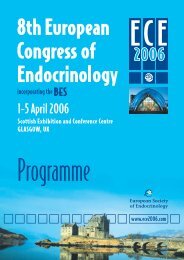
![The Endocrinologist | Issue 99 [PDF] - Society for Endocrinology](https://img.yumpu.com/48213777/1/184x260/the-endocrinologist-issue-99-pdf-society-for-endocrinology.jpg?quality=85)
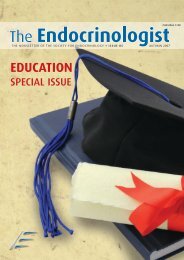
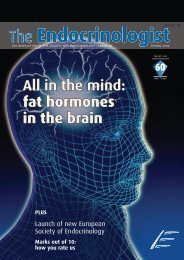
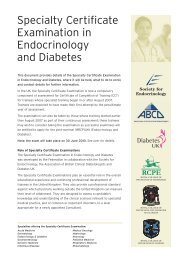
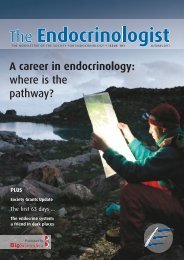
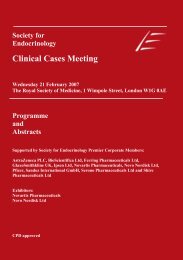

![The Endocrinologist | Issue 97 [PDF] - Society for Endocrinology](https://img.yumpu.com/40840065/1/184x260/the-endocrinologist-issue-97-pdf-society-for-endocrinology.jpg?quality=85)
